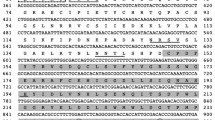Abstract
In the Japanese horseshoe crab, Tachypleus tridentatus, one of the major defense systems is carried by hemolymph that contains granular hemocytes comprising 99% of the total hemocytes. These granular hemocytes are filled with two populations of secretory granules, named large (L) and small (S) granules. These granules selectively store defense molecules, such as clotting serine protease zymogens, a clottable protein coagulogen, protease inhibitors, lectins, and antimicrobial peptides (1–3). The hemocytes are highly sensitive to LPS and these defense molecules stored in both granules are secreted by exocytosis after stimulation with LPS. This response is important for the host defense related to engulfing and killing invading microbes, in addition to preventing the leakage of hemolymph.
Access this chapter
Tax calculation will be finalised at checkout
Purchases are for personal use only
Preview
Unable to display preview. Download preview PDF.
Similar content being viewed by others
References
Muta, T., and Iwanaga, S. (1996), XXX, Curr. Opin. Immunol., 8, 41–47
Kawabata, S., Muta, T., and Iwanaga, S.(1996) in New Directions in Invertebrate Immunology (Söderhäll, K., Iwanaga, S., and Vasta, G. R., eds) pp. 255–284, SOS Publications, Fair Haven, NJ
Iwanaga, S., Kawabata, S., and Muta, T. (1998), XXX, J. Biochem. (J. B. Review) 123, 1–15
Shigenaga, T., Takayenoki, Y., Kawasaki, S., Seki, N., Muta, T., Toh, Y., Ito, A., and Iwanaga, S. (1993), XXX, J. Biochem. 114, 307–316
Saito, T., Kawabata, S., Hirata, M., and Iwanaga, S. (1995), XXX, J. Biol. Chem., 270, 14493–14499
Okino, N., Kawabata, S., Saito, T., Hirata, M., Takagi T and Iwanaga, S. (1995), XXX, J. Biol. Chcm., 270, 31008–31015
Saito, T., Hatada, M., Iwanaga, S., and Kawabata, S. (1997), XXX, J. Biol. Chem., 272, 30703–30708
Inamori, K., Saito, T., Iwaki, D., Nagira, T., Iwanaga, S., Arisaka, F., and Kawabata, S.(1999), XXX, J. Biol. Chem., 274, 3272–3278
Sikder, S. K., and Kabat, E. A. (1986), XXX, Carbohydr. Res. 151, 247–260
Leffler, H., and Barondes, S. H. (1986), XXX, J. Biol. Chem. 261, 10119–10126
Sparrow, C. P., Leffler, H., and Barondes, S. H. (1987), XXX, J. Biol. Chem. 262, 7383–7390
Rini, J. M. (1995), XXX, Annu. Rev. Biophys. Biomol. Struct. 24, 551–577
Armstrong, P. B., and Rickles, F. R. (1982), XXX, Exp. Cell Res. 140, 15–24
Miura, Y., Kawabata, S., Wakamiya, Y., Nakamura, T., and Iwanaga, S. (1995), XXX, J. Biol. Chem. 270, 558–565
Mandrell, R. E., Apicella, M. A., Lindstedt, R., Leffler, H. (1994), XXX, Methods Enzymol. 236, 231–254
Sato, S., and Hughes, R. C. (1994), XXX, J. Biol. Chem. 269, 4424–4430
Mey, A., Leffler, H., Hmama, Z., Normier, G., and Revillard, J.-P. (1996), XXX, J. Immunol. 156, 1572–1577
Author information
Authors and Affiliations
Editor information
Editors and Affiliations
Rights and permissions
Copyright information
© 2001 Springer Science+Business Media New York
About this chapter
Cite this chapter
Inamori, K. et al. (2001). Horseshoe Crab Hemocyte- Derived Lectin Recognizing Specific 0-Antigens of Lipopolysaccharides. In: Beck, G., Sugumaran, M., Cooper, E.L. (eds) Phylogenetic Perspectives on the Vertebrate Immune System. Advances in Experimental Medicine and Biology, vol 484. Springer, Boston, MA. https://doi.org/10.1007/978-1-4615-1291-2_16
Download citation
DOI: https://doi.org/10.1007/978-1-4615-1291-2_16
Publisher Name: Springer, Boston, MA
Print ISBN: 978-1-4613-5481-9
Online ISBN: 978-1-4615-1291-2
eBook Packages: Springer Book Archive




